Argumentative Essay: Transformational Leadership in Early Years
VerifiedAdded on 2020/04/13
|11
|4136
|51
Essay
AI Summary
This argumentative essay delves into the concept of transformational leadership within the context of early years education. It begins by defining transformational leadership and highlighting its potential benefits in fostering motivation and effective learning among young students. The essay explores the advantages of early exposure to leadership principles, emphasizing the development of confidence, self-analysis, and decision-making skills. It also acknowledges potential shortcomings, such as the challenges of implementing formal leadership behaviors in early childhood and the importance of teacher communication. The essay focuses on five key traits of effective leadership in early years, connecting transformational leadership with distributed leadership. It also touches upon the characteristics of a good leader in early years education. The essay concludes by reinforcing the positive impact of transformational leadership in early years, underscoring its role in shaping children's growth and decision-making abilities.
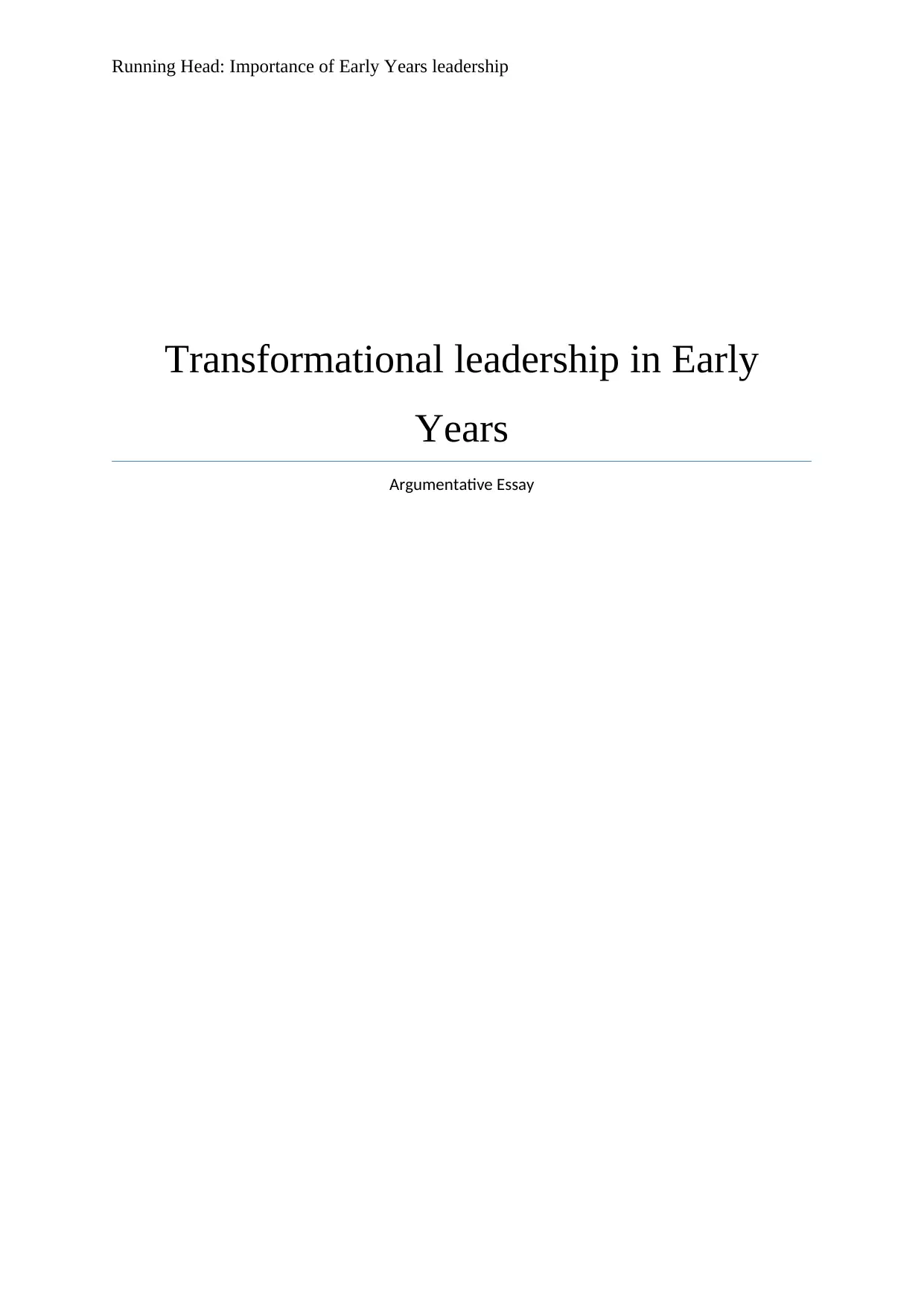
Running Head: Importance of Early Years leadership
Transformational leadership in Early
Years
Argumentative Essay
Transformational leadership in Early
Years
Argumentative Essay
Paraphrase This Document
Need a fresh take? Get an instant paraphrase of this document with our AI Paraphraser
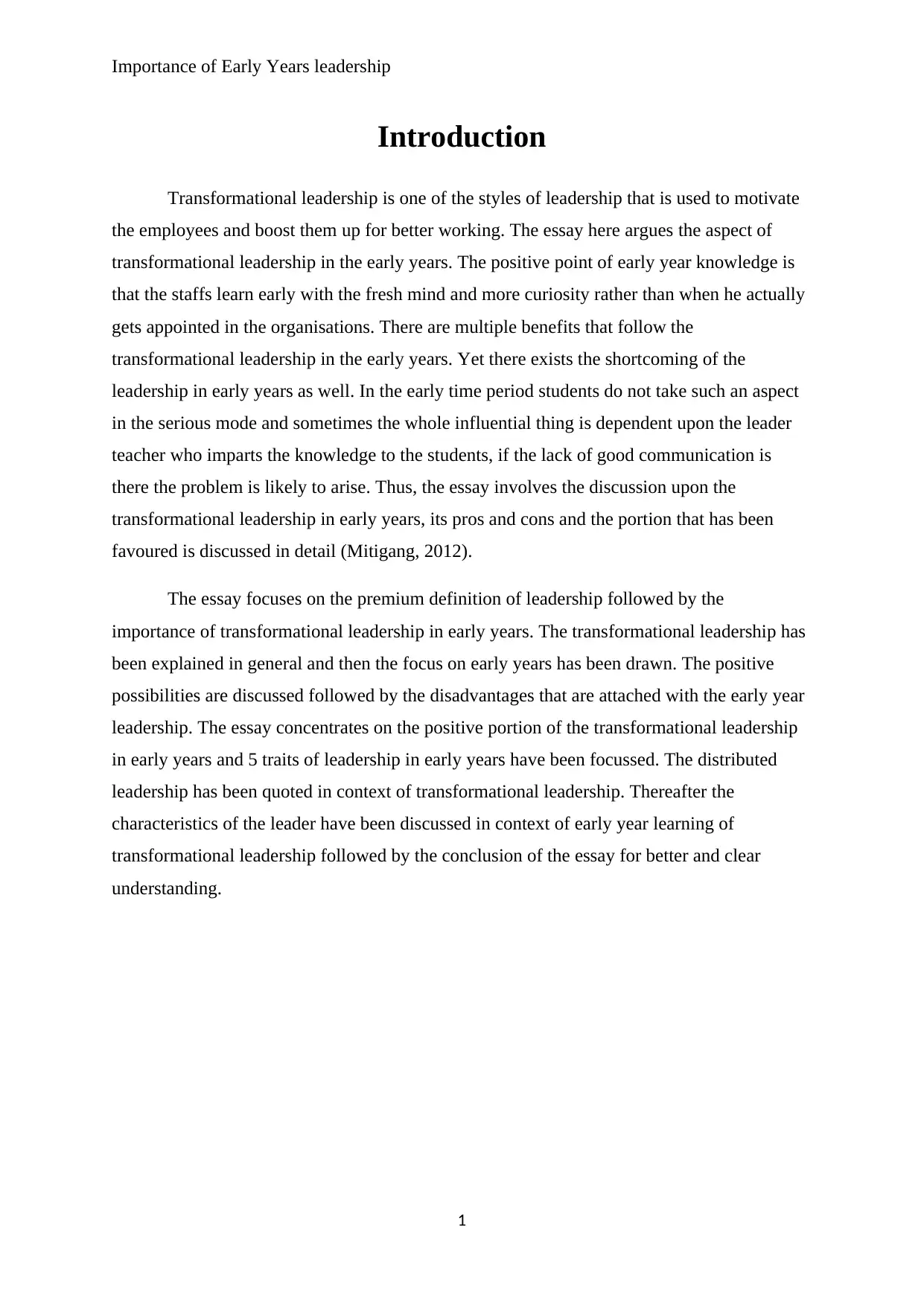
Importance of Early Years leadership
Introduction
Transformational leadership is one of the styles of leadership that is used to motivate
the employees and boost them up for better working. The essay here argues the aspect of
transformational leadership in the early years. The positive point of early year knowledge is
that the staffs learn early with the fresh mind and more curiosity rather than when he actually
gets appointed in the organisations. There are multiple benefits that follow the
transformational leadership in the early years. Yet there exists the shortcoming of the
leadership in early years as well. In the early time period students do not take such an aspect
in the serious mode and sometimes the whole influential thing is dependent upon the leader
teacher who imparts the knowledge to the students, if the lack of good communication is
there the problem is likely to arise. Thus, the essay involves the discussion upon the
transformational leadership in early years, its pros and cons and the portion that has been
favoured is discussed in detail (Mitigang, 2012).
The essay focuses on the premium definition of leadership followed by the
importance of transformational leadership in early years. The transformational leadership has
been explained in general and then the focus on early years has been drawn. The positive
possibilities are discussed followed by the disadvantages that are attached with the early year
leadership. The essay concentrates on the positive portion of the transformational leadership
in early years and 5 traits of leadership in early years have been focussed. The distributed
leadership has been quoted in context of transformational leadership. Thereafter the
characteristics of the leader have been discussed in context of early year learning of
transformational leadership followed by the conclusion of the essay for better and clear
understanding.
1
Introduction
Transformational leadership is one of the styles of leadership that is used to motivate
the employees and boost them up for better working. The essay here argues the aspect of
transformational leadership in the early years. The positive point of early year knowledge is
that the staffs learn early with the fresh mind and more curiosity rather than when he actually
gets appointed in the organisations. There are multiple benefits that follow the
transformational leadership in the early years. Yet there exists the shortcoming of the
leadership in early years as well. In the early time period students do not take such an aspect
in the serious mode and sometimes the whole influential thing is dependent upon the leader
teacher who imparts the knowledge to the students, if the lack of good communication is
there the problem is likely to arise. Thus, the essay involves the discussion upon the
transformational leadership in early years, its pros and cons and the portion that has been
favoured is discussed in detail (Mitigang, 2012).
The essay focuses on the premium definition of leadership followed by the
importance of transformational leadership in early years. The transformational leadership has
been explained in general and then the focus on early years has been drawn. The positive
possibilities are discussed followed by the disadvantages that are attached with the early year
leadership. The essay concentrates on the positive portion of the transformational leadership
in early years and 5 traits of leadership in early years have been focussed. The distributed
leadership has been quoted in context of transformational leadership. Thereafter the
characteristics of the leader have been discussed in context of early year learning of
transformational leadership followed by the conclusion of the essay for better and clear
understanding.
1
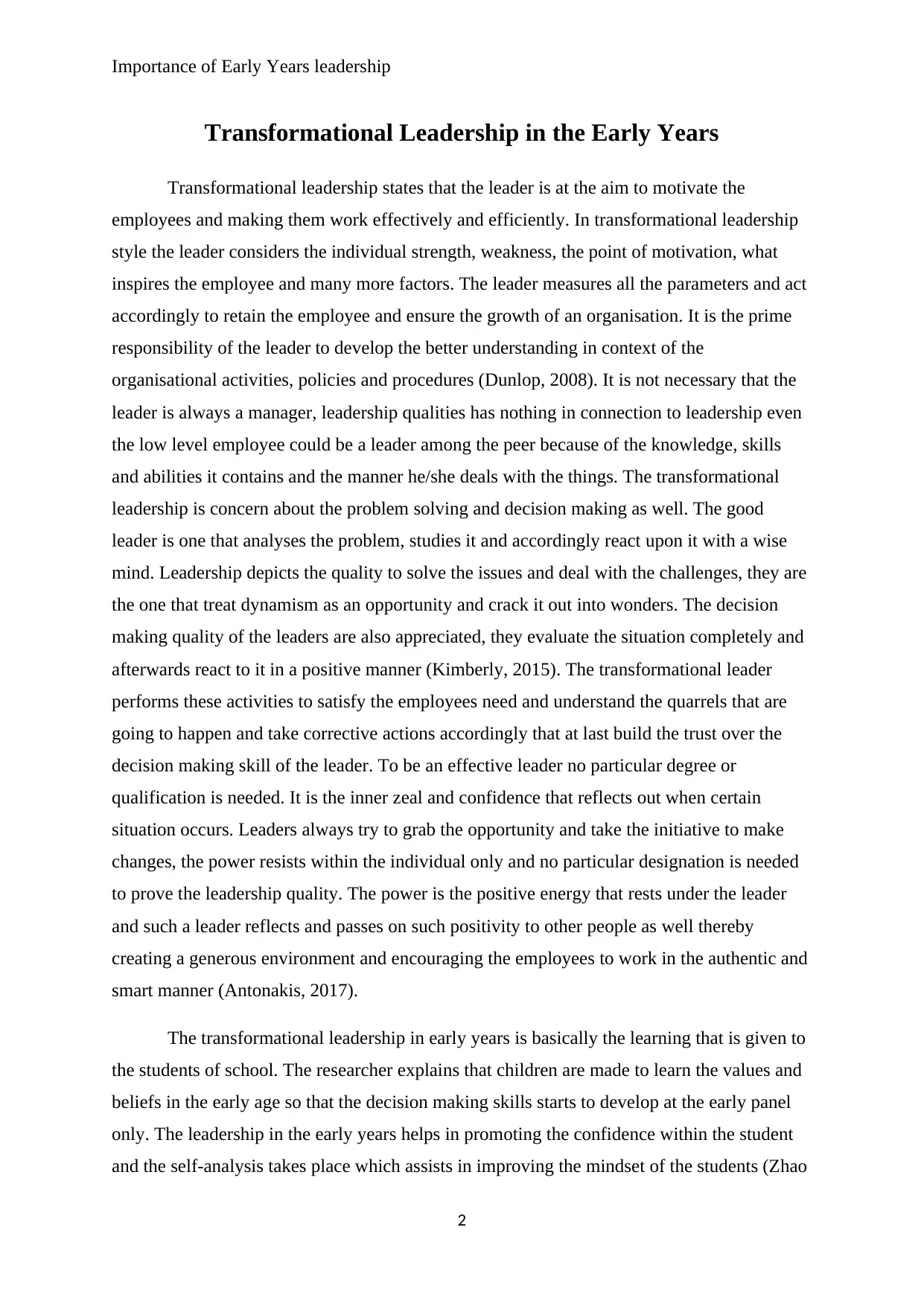
Importance of Early Years leadership
Transformational Leadership in the Early Years
Transformational leadership states that the leader is at the aim to motivate the
employees and making them work effectively and efficiently. In transformational leadership
style the leader considers the individual strength, weakness, the point of motivation, what
inspires the employee and many more factors. The leader measures all the parameters and act
accordingly to retain the employee and ensure the growth of an organisation. It is the prime
responsibility of the leader to develop the better understanding in context of the
organisational activities, policies and procedures (Dunlop, 2008). It is not necessary that the
leader is always a manager, leadership qualities has nothing in connection to leadership even
the low level employee could be a leader among the peer because of the knowledge, skills
and abilities it contains and the manner he/she deals with the things. The transformational
leadership is concern about the problem solving and decision making as well. The good
leader is one that analyses the problem, studies it and accordingly react upon it with a wise
mind. Leadership depicts the quality to solve the issues and deal with the challenges, they are
the one that treat dynamism as an opportunity and crack it out into wonders. The decision
making quality of the leaders are also appreciated, they evaluate the situation completely and
afterwards react to it in a positive manner (Kimberly, 2015). The transformational leader
performs these activities to satisfy the employees need and understand the quarrels that are
going to happen and take corrective actions accordingly that at last build the trust over the
decision making skill of the leader. To be an effective leader no particular degree or
qualification is needed. It is the inner zeal and confidence that reflects out when certain
situation occurs. Leaders always try to grab the opportunity and take the initiative to make
changes, the power resists within the individual only and no particular designation is needed
to prove the leadership quality. The power is the positive energy that rests under the leader
and such a leader reflects and passes on such positivity to other people as well thereby
creating a generous environment and encouraging the employees to work in the authentic and
smart manner (Antonakis, 2017).
The transformational leadership in early years is basically the learning that is given to
the students of school. The researcher explains that children are made to learn the values and
beliefs in the early age so that the decision making skills starts to develop at the early panel
only. The leadership in the early years helps in promoting the confidence within the student
and the self-analysis takes place which assists in improving the mindset of the students (Zhao
2
Transformational Leadership in the Early Years
Transformational leadership states that the leader is at the aim to motivate the
employees and making them work effectively and efficiently. In transformational leadership
style the leader considers the individual strength, weakness, the point of motivation, what
inspires the employee and many more factors. The leader measures all the parameters and act
accordingly to retain the employee and ensure the growth of an organisation. It is the prime
responsibility of the leader to develop the better understanding in context of the
organisational activities, policies and procedures (Dunlop, 2008). It is not necessary that the
leader is always a manager, leadership qualities has nothing in connection to leadership even
the low level employee could be a leader among the peer because of the knowledge, skills
and abilities it contains and the manner he/she deals with the things. The transformational
leadership is concern about the problem solving and decision making as well. The good
leader is one that analyses the problem, studies it and accordingly react upon it with a wise
mind. Leadership depicts the quality to solve the issues and deal with the challenges, they are
the one that treat dynamism as an opportunity and crack it out into wonders. The decision
making quality of the leaders are also appreciated, they evaluate the situation completely and
afterwards react to it in a positive manner (Kimberly, 2015). The transformational leader
performs these activities to satisfy the employees need and understand the quarrels that are
going to happen and take corrective actions accordingly that at last build the trust over the
decision making skill of the leader. To be an effective leader no particular degree or
qualification is needed. It is the inner zeal and confidence that reflects out when certain
situation occurs. Leaders always try to grab the opportunity and take the initiative to make
changes, the power resists within the individual only and no particular designation is needed
to prove the leadership quality. The power is the positive energy that rests under the leader
and such a leader reflects and passes on such positivity to other people as well thereby
creating a generous environment and encouraging the employees to work in the authentic and
smart manner (Antonakis, 2017).
The transformational leadership in early years is basically the learning that is given to
the students of school. The researcher explains that children are made to learn the values and
beliefs in the early age so that the decision making skills starts to develop at the early panel
only. The leadership in the early years helps in promoting the confidence within the student
and the self-analysis takes place which assists in improving the mindset of the students (Zhao
2
⊘ This is a preview!⊘
Do you want full access?
Subscribe today to unlock all pages.

Trusted by 1+ million students worldwide
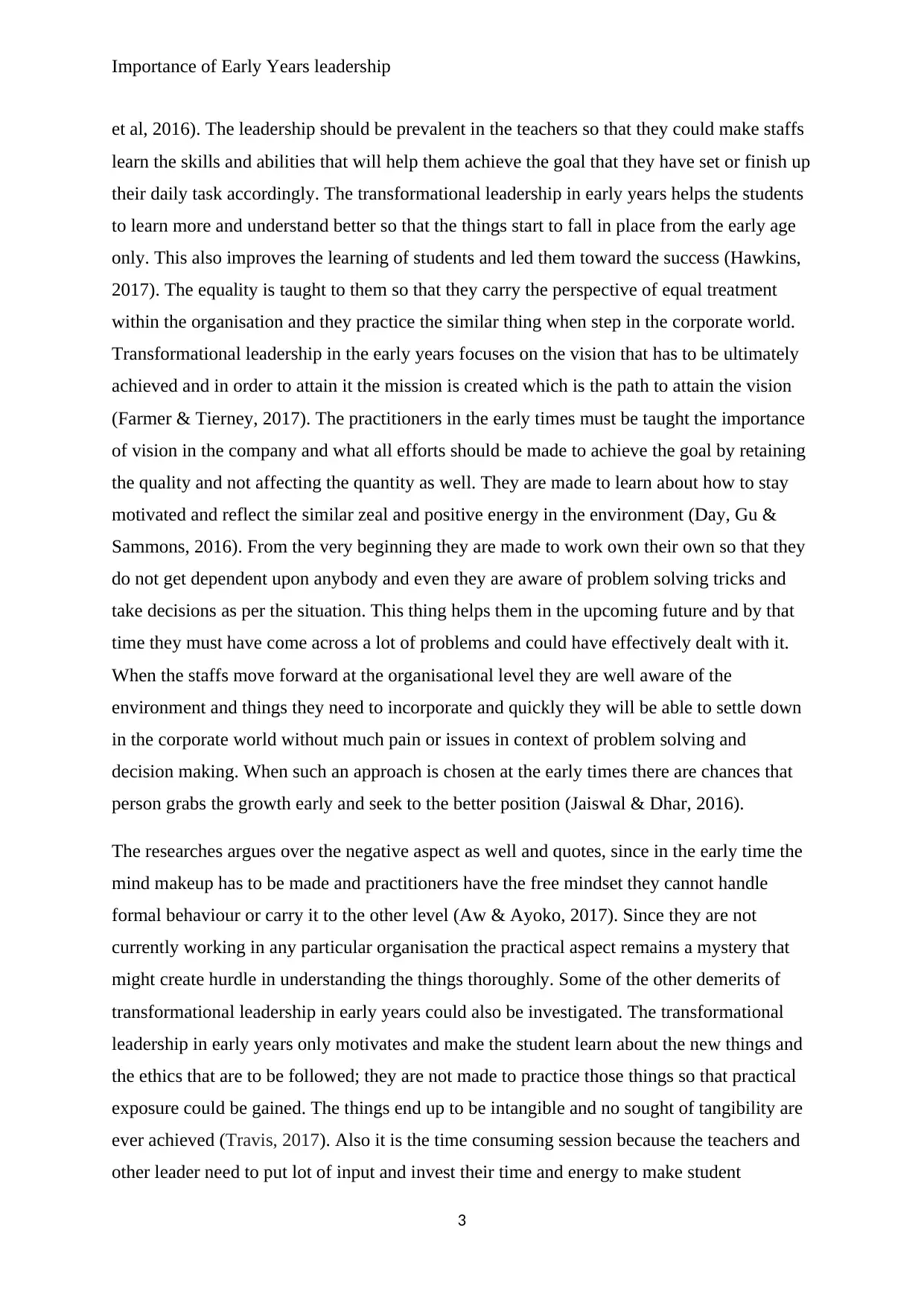
Importance of Early Years leadership
et al, 2016). The leadership should be prevalent in the teachers so that they could make staffs
learn the skills and abilities that will help them achieve the goal that they have set or finish up
their daily task accordingly. The transformational leadership in early years helps the students
to learn more and understand better so that the things start to fall in place from the early age
only. This also improves the learning of students and led them toward the success (Hawkins,
2017). The equality is taught to them so that they carry the perspective of equal treatment
within the organisation and they practice the similar thing when step in the corporate world.
Transformational leadership in the early years focuses on the vision that has to be ultimately
achieved and in order to attain it the mission is created which is the path to attain the vision
(Farmer & Tierney, 2017). The practitioners in the early times must be taught the importance
of vision in the company and what all efforts should be made to achieve the goal by retaining
the quality and not affecting the quantity as well. They are made to learn about how to stay
motivated and reflect the similar zeal and positive energy in the environment (Day, Gu &
Sammons, 2016). From the very beginning they are made to work own their own so that they
do not get dependent upon anybody and even they are aware of problem solving tricks and
take decisions as per the situation. This thing helps them in the upcoming future and by that
time they must have come across a lot of problems and could have effectively dealt with it.
When the staffs move forward at the organisational level they are well aware of the
environment and things they need to incorporate and quickly they will be able to settle down
in the corporate world without much pain or issues in context of problem solving and
decision making. When such an approach is chosen at the early times there are chances that
person grabs the growth early and seek to the better position (Jaiswal & Dhar, 2016).
The researches argues over the negative aspect as well and quotes, since in the early time the
mind makeup has to be made and practitioners have the free mindset they cannot handle
formal behaviour or carry it to the other level (Aw & Ayoko, 2017). Since they are not
currently working in any particular organisation the practical aspect remains a mystery that
might create hurdle in understanding the things thoroughly. Some of the other demerits of
transformational leadership in early years could also be investigated. The transformational
leadership in early years only motivates and make the student learn about the new things and
the ethics that are to be followed; they are not made to practice those things so that practical
exposure could be gained. The things end up to be intangible and no sought of tangibility are
ever achieved (Travis, 2017). Also it is the time consuming session because the teachers and
other leader need to put lot of input and invest their time and energy to make student
3
et al, 2016). The leadership should be prevalent in the teachers so that they could make staffs
learn the skills and abilities that will help them achieve the goal that they have set or finish up
their daily task accordingly. The transformational leadership in early years helps the students
to learn more and understand better so that the things start to fall in place from the early age
only. This also improves the learning of students and led them toward the success (Hawkins,
2017). The equality is taught to them so that they carry the perspective of equal treatment
within the organisation and they practice the similar thing when step in the corporate world.
Transformational leadership in the early years focuses on the vision that has to be ultimately
achieved and in order to attain it the mission is created which is the path to attain the vision
(Farmer & Tierney, 2017). The practitioners in the early times must be taught the importance
of vision in the company and what all efforts should be made to achieve the goal by retaining
the quality and not affecting the quantity as well. They are made to learn about how to stay
motivated and reflect the similar zeal and positive energy in the environment (Day, Gu &
Sammons, 2016). From the very beginning they are made to work own their own so that they
do not get dependent upon anybody and even they are aware of problem solving tricks and
take decisions as per the situation. This thing helps them in the upcoming future and by that
time they must have come across a lot of problems and could have effectively dealt with it.
When the staffs move forward at the organisational level they are well aware of the
environment and things they need to incorporate and quickly they will be able to settle down
in the corporate world without much pain or issues in context of problem solving and
decision making. When such an approach is chosen at the early times there are chances that
person grabs the growth early and seek to the better position (Jaiswal & Dhar, 2016).
The researches argues over the negative aspect as well and quotes, since in the early time the
mind makeup has to be made and practitioners have the free mindset they cannot handle
formal behaviour or carry it to the other level (Aw & Ayoko, 2017). Since they are not
currently working in any particular organisation the practical aspect remains a mystery that
might create hurdle in understanding the things thoroughly. Some of the other demerits of
transformational leadership in early years could also be investigated. The transformational
leadership in early years only motivates and make the student learn about the new things and
the ethics that are to be followed; they are not made to practice those things so that practical
exposure could be gained. The things end up to be intangible and no sought of tangibility are
ever achieved (Travis, 2017). Also it is the time consuming session because the teachers and
other leader need to put lot of input and invest their time and energy to make student
3
Paraphrase This Document
Need a fresh take? Get an instant paraphrase of this document with our AI Paraphraser
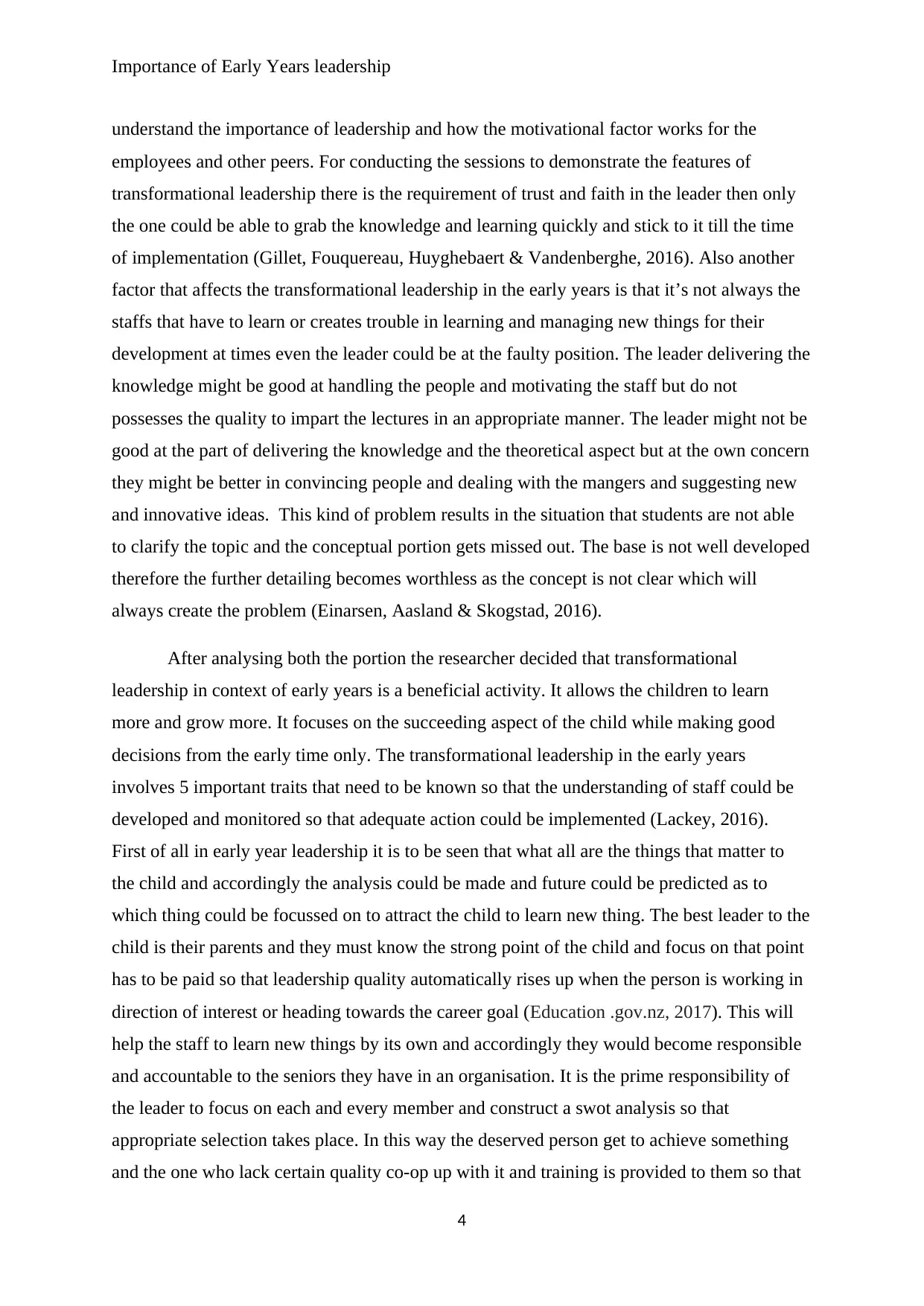
Importance of Early Years leadership
understand the importance of leadership and how the motivational factor works for the
employees and other peers. For conducting the sessions to demonstrate the features of
transformational leadership there is the requirement of trust and faith in the leader then only
the one could be able to grab the knowledge and learning quickly and stick to it till the time
of implementation (Gillet, Fouquereau, Huyghebaert & Vandenberghe, 2016). Also another
factor that affects the transformational leadership in the early years is that it’s not always the
staffs that have to learn or creates trouble in learning and managing new things for their
development at times even the leader could be at the faulty position. The leader delivering the
knowledge might be good at handling the people and motivating the staff but do not
possesses the quality to impart the lectures in an appropriate manner. The leader might not be
good at the part of delivering the knowledge and the theoretical aspect but at the own concern
they might be better in convincing people and dealing with the mangers and suggesting new
and innovative ideas. This kind of problem results in the situation that students are not able
to clarify the topic and the conceptual portion gets missed out. The base is not well developed
therefore the further detailing becomes worthless as the concept is not clear which will
always create the problem (Einarsen, Aasland & Skogstad, 2016).
After analysing both the portion the researcher decided that transformational
leadership in context of early years is a beneficial activity. It allows the children to learn
more and grow more. It focuses on the succeeding aspect of the child while making good
decisions from the early time only. The transformational leadership in the early years
involves 5 important traits that need to be known so that the understanding of staff could be
developed and monitored so that adequate action could be implemented (Lackey, 2016).
First of all in early year leadership it is to be seen that what all are the things that matter to
the child and accordingly the analysis could be made and future could be predicted as to
which thing could be focussed on to attract the child to learn new thing. The best leader to the
child is their parents and they must know the strong point of the child and focus on that point
has to be paid so that leadership quality automatically rises up when the person is working in
direction of interest or heading towards the career goal (Education .gov.nz, 2017). This will
help the staff to learn new things by its own and accordingly they would become responsible
and accountable to the seniors they have in an organisation. It is the prime responsibility of
the leader to focus on each and every member and construct a swot analysis so that
appropriate selection takes place. In this way the deserved person get to achieve something
and the one who lack certain quality co-op up with it and training is provided to them so that
4
understand the importance of leadership and how the motivational factor works for the
employees and other peers. For conducting the sessions to demonstrate the features of
transformational leadership there is the requirement of trust and faith in the leader then only
the one could be able to grab the knowledge and learning quickly and stick to it till the time
of implementation (Gillet, Fouquereau, Huyghebaert & Vandenberghe, 2016). Also another
factor that affects the transformational leadership in the early years is that it’s not always the
staffs that have to learn or creates trouble in learning and managing new things for their
development at times even the leader could be at the faulty position. The leader delivering the
knowledge might be good at handling the people and motivating the staff but do not
possesses the quality to impart the lectures in an appropriate manner. The leader might not be
good at the part of delivering the knowledge and the theoretical aspect but at the own concern
they might be better in convincing people and dealing with the mangers and suggesting new
and innovative ideas. This kind of problem results in the situation that students are not able
to clarify the topic and the conceptual portion gets missed out. The base is not well developed
therefore the further detailing becomes worthless as the concept is not clear which will
always create the problem (Einarsen, Aasland & Skogstad, 2016).
After analysing both the portion the researcher decided that transformational
leadership in context of early years is a beneficial activity. It allows the children to learn
more and grow more. It focuses on the succeeding aspect of the child while making good
decisions from the early time only. The transformational leadership in the early years
involves 5 important traits that need to be known so that the understanding of staff could be
developed and monitored so that adequate action could be implemented (Lackey, 2016).
First of all in early year leadership it is to be seen that what all are the things that matter to
the child and accordingly the analysis could be made and future could be predicted as to
which thing could be focussed on to attract the child to learn new thing. The best leader to the
child is their parents and they must know the strong point of the child and focus on that point
has to be paid so that leadership quality automatically rises up when the person is working in
direction of interest or heading towards the career goal (Education .gov.nz, 2017). This will
help the staff to learn new things by its own and accordingly they would become responsible
and accountable to the seniors they have in an organisation. It is the prime responsibility of
the leader to focus on each and every member and construct a swot analysis so that
appropriate selection takes place. In this way the deserved person get to achieve something
and the one who lack certain quality co-op up with it and training is provided to them so that
4
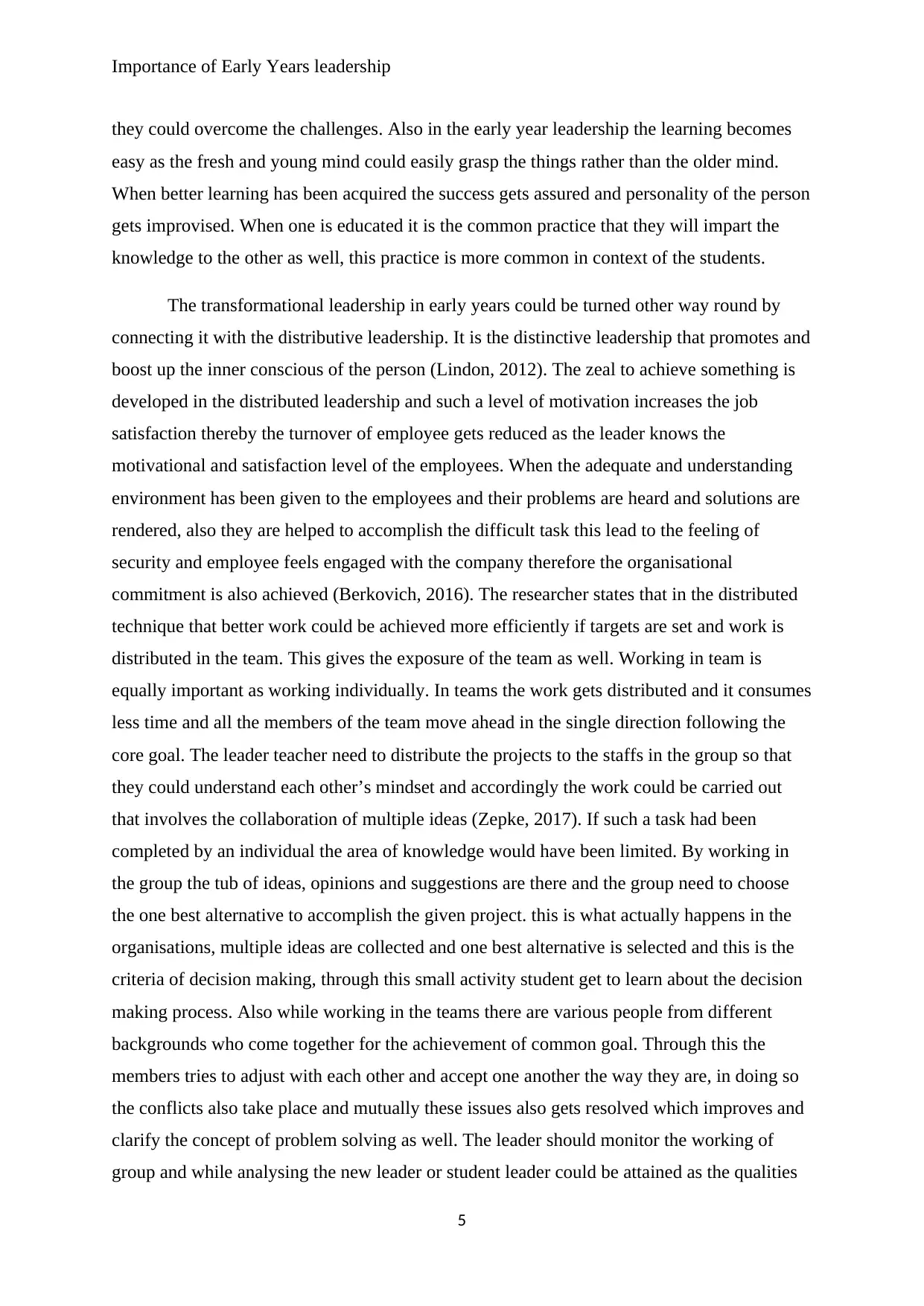
Importance of Early Years leadership
they could overcome the challenges. Also in the early year leadership the learning becomes
easy as the fresh and young mind could easily grasp the things rather than the older mind.
When better learning has been acquired the success gets assured and personality of the person
gets improvised. When one is educated it is the common practice that they will impart the
knowledge to the other as well, this practice is more common in context of the students.
The transformational leadership in early years could be turned other way round by
connecting it with the distributive leadership. It is the distinctive leadership that promotes and
boost up the inner conscious of the person (Lindon, 2012). The zeal to achieve something is
developed in the distributed leadership and such a level of motivation increases the job
satisfaction thereby the turnover of employee gets reduced as the leader knows the
motivational and satisfaction level of the employees. When the adequate and understanding
environment has been given to the employees and their problems are heard and solutions are
rendered, also they are helped to accomplish the difficult task this lead to the feeling of
security and employee feels engaged with the company therefore the organisational
commitment is also achieved (Berkovich, 2016). The researcher states that in the distributed
technique that better work could be achieved more efficiently if targets are set and work is
distributed in the team. This gives the exposure of the team as well. Working in team is
equally important as working individually. In teams the work gets distributed and it consumes
less time and all the members of the team move ahead in the single direction following the
core goal. The leader teacher need to distribute the projects to the staffs in the group so that
they could understand each other’s mindset and accordingly the work could be carried out
that involves the collaboration of multiple ideas (Zepke, 2017). If such a task had been
completed by an individual the area of knowledge would have been limited. By working in
the group the tub of ideas, opinions and suggestions are there and the group need to choose
the one best alternative to accomplish the given project. this is what actually happens in the
organisations, multiple ideas are collected and one best alternative is selected and this is the
criteria of decision making, through this small activity student get to learn about the decision
making process. Also while working in the teams there are various people from different
backgrounds who come together for the achievement of common goal. Through this the
members tries to adjust with each other and accept one another the way they are, in doing so
the conflicts also take place and mutually these issues also gets resolved which improves and
clarify the concept of problem solving as well. The leader should monitor the working of
group and while analysing the new leader or student leader could be attained as the qualities
5
they could overcome the challenges. Also in the early year leadership the learning becomes
easy as the fresh and young mind could easily grasp the things rather than the older mind.
When better learning has been acquired the success gets assured and personality of the person
gets improvised. When one is educated it is the common practice that they will impart the
knowledge to the other as well, this practice is more common in context of the students.
The transformational leadership in early years could be turned other way round by
connecting it with the distributive leadership. It is the distinctive leadership that promotes and
boost up the inner conscious of the person (Lindon, 2012). The zeal to achieve something is
developed in the distributed leadership and such a level of motivation increases the job
satisfaction thereby the turnover of employee gets reduced as the leader knows the
motivational and satisfaction level of the employees. When the adequate and understanding
environment has been given to the employees and their problems are heard and solutions are
rendered, also they are helped to accomplish the difficult task this lead to the feeling of
security and employee feels engaged with the company therefore the organisational
commitment is also achieved (Berkovich, 2016). The researcher states that in the distributed
technique that better work could be achieved more efficiently if targets are set and work is
distributed in the team. This gives the exposure of the team as well. Working in team is
equally important as working individually. In teams the work gets distributed and it consumes
less time and all the members of the team move ahead in the single direction following the
core goal. The leader teacher need to distribute the projects to the staffs in the group so that
they could understand each other’s mindset and accordingly the work could be carried out
that involves the collaboration of multiple ideas (Zepke, 2017). If such a task had been
completed by an individual the area of knowledge would have been limited. By working in
the group the tub of ideas, opinions and suggestions are there and the group need to choose
the one best alternative to accomplish the given project. this is what actually happens in the
organisations, multiple ideas are collected and one best alternative is selected and this is the
criteria of decision making, through this small activity student get to learn about the decision
making process. Also while working in the teams there are various people from different
backgrounds who come together for the achievement of common goal. Through this the
members tries to adjust with each other and accept one another the way they are, in doing so
the conflicts also take place and mutually these issues also gets resolved which improves and
clarify the concept of problem solving as well. The leader should monitor the working of
group and while analysing the new leader or student leader could be attained as the qualities
5
⊘ This is a preview!⊘
Do you want full access?
Subscribe today to unlock all pages.

Trusted by 1+ million students worldwide
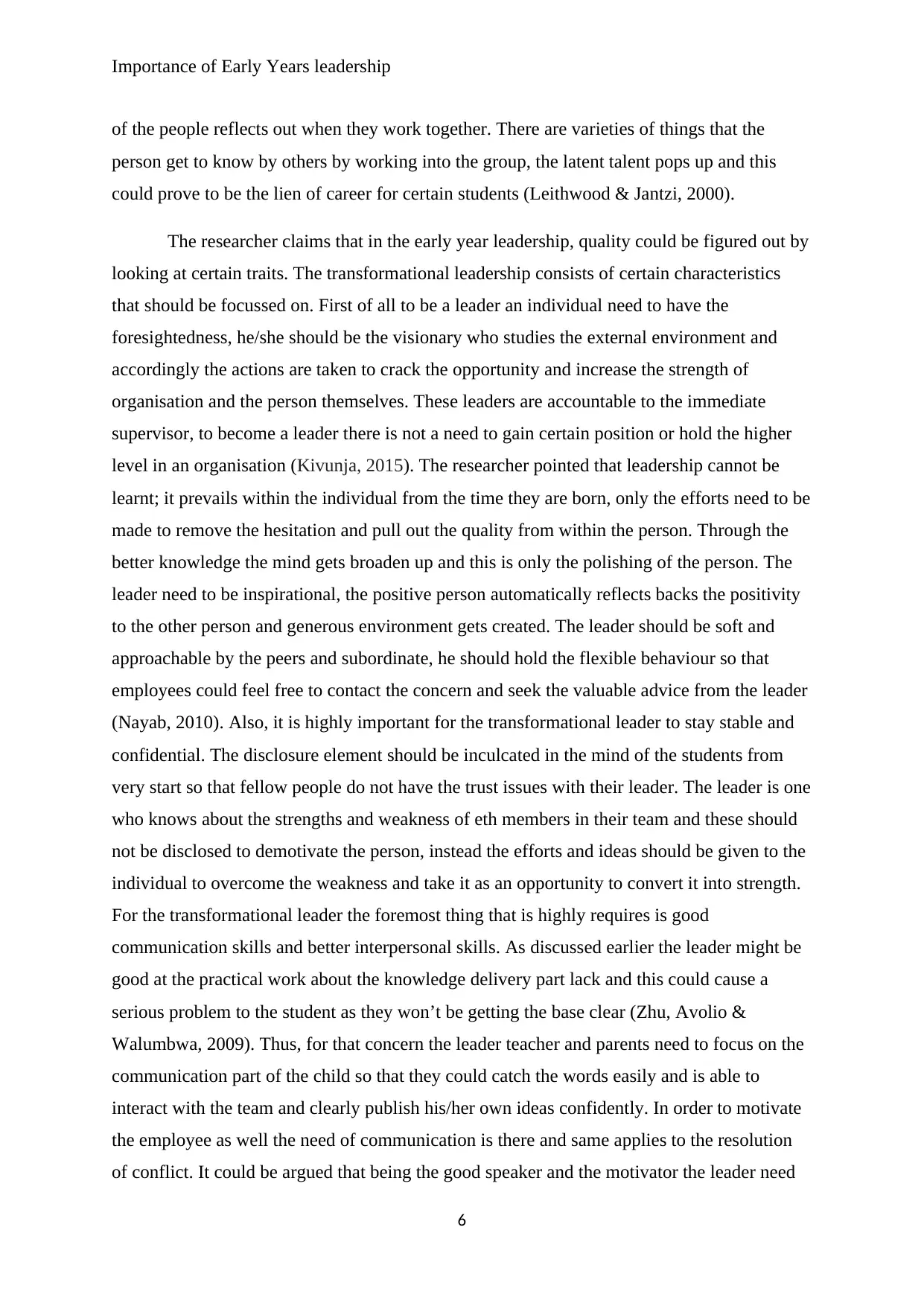
Importance of Early Years leadership
of the people reflects out when they work together. There are varieties of things that the
person get to know by others by working into the group, the latent talent pops up and this
could prove to be the lien of career for certain students (Leithwood & Jantzi, 2000).
The researcher claims that in the early year leadership, quality could be figured out by
looking at certain traits. The transformational leadership consists of certain characteristics
that should be focussed on. First of all to be a leader an individual need to have the
foresightedness, he/she should be the visionary who studies the external environment and
accordingly the actions are taken to crack the opportunity and increase the strength of
organisation and the person themselves. These leaders are accountable to the immediate
supervisor, to become a leader there is not a need to gain certain position or hold the higher
level in an organisation (Kivunja, 2015). The researcher pointed that leadership cannot be
learnt; it prevails within the individual from the time they are born, only the efforts need to be
made to remove the hesitation and pull out the quality from within the person. Through the
better knowledge the mind gets broaden up and this is only the polishing of the person. The
leader need to be inspirational, the positive person automatically reflects backs the positivity
to the other person and generous environment gets created. The leader should be soft and
approachable by the peers and subordinate, he should hold the flexible behaviour so that
employees could feel free to contact the concern and seek the valuable advice from the leader
(Nayab, 2010). Also, it is highly important for the transformational leader to stay stable and
confidential. The disclosure element should be inculcated in the mind of the students from
very start so that fellow people do not have the trust issues with their leader. The leader is one
who knows about the strengths and weakness of eth members in their team and these should
not be disclosed to demotivate the person, instead the efforts and ideas should be given to the
individual to overcome the weakness and take it as an opportunity to convert it into strength.
For the transformational leader the foremost thing that is highly requires is good
communication skills and better interpersonal skills. As discussed earlier the leader might be
good at the practical work about the knowledge delivery part lack and this could cause a
serious problem to the student as they won’t be getting the base clear (Zhu, Avolio &
Walumbwa, 2009). Thus, for that concern the leader teacher and parents need to focus on the
communication part of the child so that they could catch the words easily and is able to
interact with the team and clearly publish his/her own ideas confidently. In order to motivate
the employee as well the need of communication is there and same applies to the resolution
of conflict. It could be argued that being the good speaker and the motivator the leader need
6
of the people reflects out when they work together. There are varieties of things that the
person get to know by others by working into the group, the latent talent pops up and this
could prove to be the lien of career for certain students (Leithwood & Jantzi, 2000).
The researcher claims that in the early year leadership, quality could be figured out by
looking at certain traits. The transformational leadership consists of certain characteristics
that should be focussed on. First of all to be a leader an individual need to have the
foresightedness, he/she should be the visionary who studies the external environment and
accordingly the actions are taken to crack the opportunity and increase the strength of
organisation and the person themselves. These leaders are accountable to the immediate
supervisor, to become a leader there is not a need to gain certain position or hold the higher
level in an organisation (Kivunja, 2015). The researcher pointed that leadership cannot be
learnt; it prevails within the individual from the time they are born, only the efforts need to be
made to remove the hesitation and pull out the quality from within the person. Through the
better knowledge the mind gets broaden up and this is only the polishing of the person. The
leader need to be inspirational, the positive person automatically reflects backs the positivity
to the other person and generous environment gets created. The leader should be soft and
approachable by the peers and subordinate, he should hold the flexible behaviour so that
employees could feel free to contact the concern and seek the valuable advice from the leader
(Nayab, 2010). Also, it is highly important for the transformational leader to stay stable and
confidential. The disclosure element should be inculcated in the mind of the students from
very start so that fellow people do not have the trust issues with their leader. The leader is one
who knows about the strengths and weakness of eth members in their team and these should
not be disclosed to demotivate the person, instead the efforts and ideas should be given to the
individual to overcome the weakness and take it as an opportunity to convert it into strength.
For the transformational leader the foremost thing that is highly requires is good
communication skills and better interpersonal skills. As discussed earlier the leader might be
good at the practical work about the knowledge delivery part lack and this could cause a
serious problem to the student as they won’t be getting the base clear (Zhu, Avolio &
Walumbwa, 2009). Thus, for that concern the leader teacher and parents need to focus on the
communication part of the child so that they could catch the words easily and is able to
interact with the team and clearly publish his/her own ideas confidently. In order to motivate
the employee as well the need of communication is there and same applies to the resolution
of conflict. It could be argued that being the good speaker and the motivator the leader need
6
Paraphrase This Document
Need a fresh take? Get an instant paraphrase of this document with our AI Paraphraser
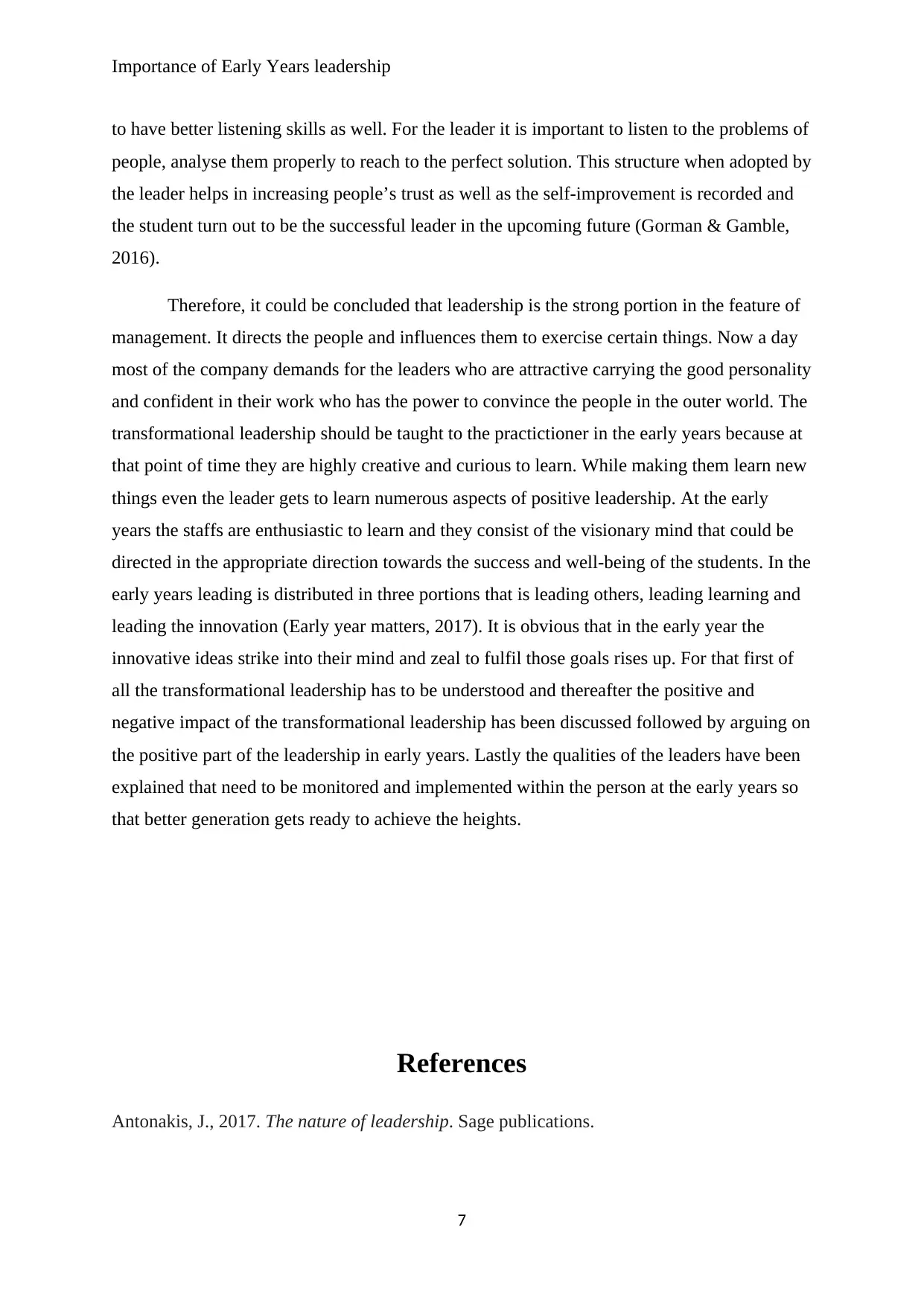
Importance of Early Years leadership
to have better listening skills as well. For the leader it is important to listen to the problems of
people, analyse them properly to reach to the perfect solution. This structure when adopted by
the leader helps in increasing people’s trust as well as the self-improvement is recorded and
the student turn out to be the successful leader in the upcoming future (Gorman & Gamble,
2016).
Therefore, it could be concluded that leadership is the strong portion in the feature of
management. It directs the people and influences them to exercise certain things. Now a day
most of the company demands for the leaders who are attractive carrying the good personality
and confident in their work who has the power to convince the people in the outer world. The
transformational leadership should be taught to the practictioner in the early years because at
that point of time they are highly creative and curious to learn. While making them learn new
things even the leader gets to learn numerous aspects of positive leadership. At the early
years the staffs are enthusiastic to learn and they consist of the visionary mind that could be
directed in the appropriate direction towards the success and well-being of the students. In the
early years leading is distributed in three portions that is leading others, leading learning and
leading the innovation (Early year matters, 2017). It is obvious that in the early year the
innovative ideas strike into their mind and zeal to fulfil those goals rises up. For that first of
all the transformational leadership has to be understood and thereafter the positive and
negative impact of the transformational leadership has been discussed followed by arguing on
the positive part of the leadership in early years. Lastly the qualities of the leaders have been
explained that need to be monitored and implemented within the person at the early years so
that better generation gets ready to achieve the heights.
References
Antonakis, J., 2017. The nature of leadership. Sage publications.
7
to have better listening skills as well. For the leader it is important to listen to the problems of
people, analyse them properly to reach to the perfect solution. This structure when adopted by
the leader helps in increasing people’s trust as well as the self-improvement is recorded and
the student turn out to be the successful leader in the upcoming future (Gorman & Gamble,
2016).
Therefore, it could be concluded that leadership is the strong portion in the feature of
management. It directs the people and influences them to exercise certain things. Now a day
most of the company demands for the leaders who are attractive carrying the good personality
and confident in their work who has the power to convince the people in the outer world. The
transformational leadership should be taught to the practictioner in the early years because at
that point of time they are highly creative and curious to learn. While making them learn new
things even the leader gets to learn numerous aspects of positive leadership. At the early
years the staffs are enthusiastic to learn and they consist of the visionary mind that could be
directed in the appropriate direction towards the success and well-being of the students. In the
early years leading is distributed in three portions that is leading others, leading learning and
leading the innovation (Early year matters, 2017). It is obvious that in the early year the
innovative ideas strike into their mind and zeal to fulfil those goals rises up. For that first of
all the transformational leadership has to be understood and thereafter the positive and
negative impact of the transformational leadership has been discussed followed by arguing on
the positive part of the leadership in early years. Lastly the qualities of the leaders have been
explained that need to be monitored and implemented within the person at the early years so
that better generation gets ready to achieve the heights.
References
Antonakis, J., 2017. The nature of leadership. Sage publications.
7
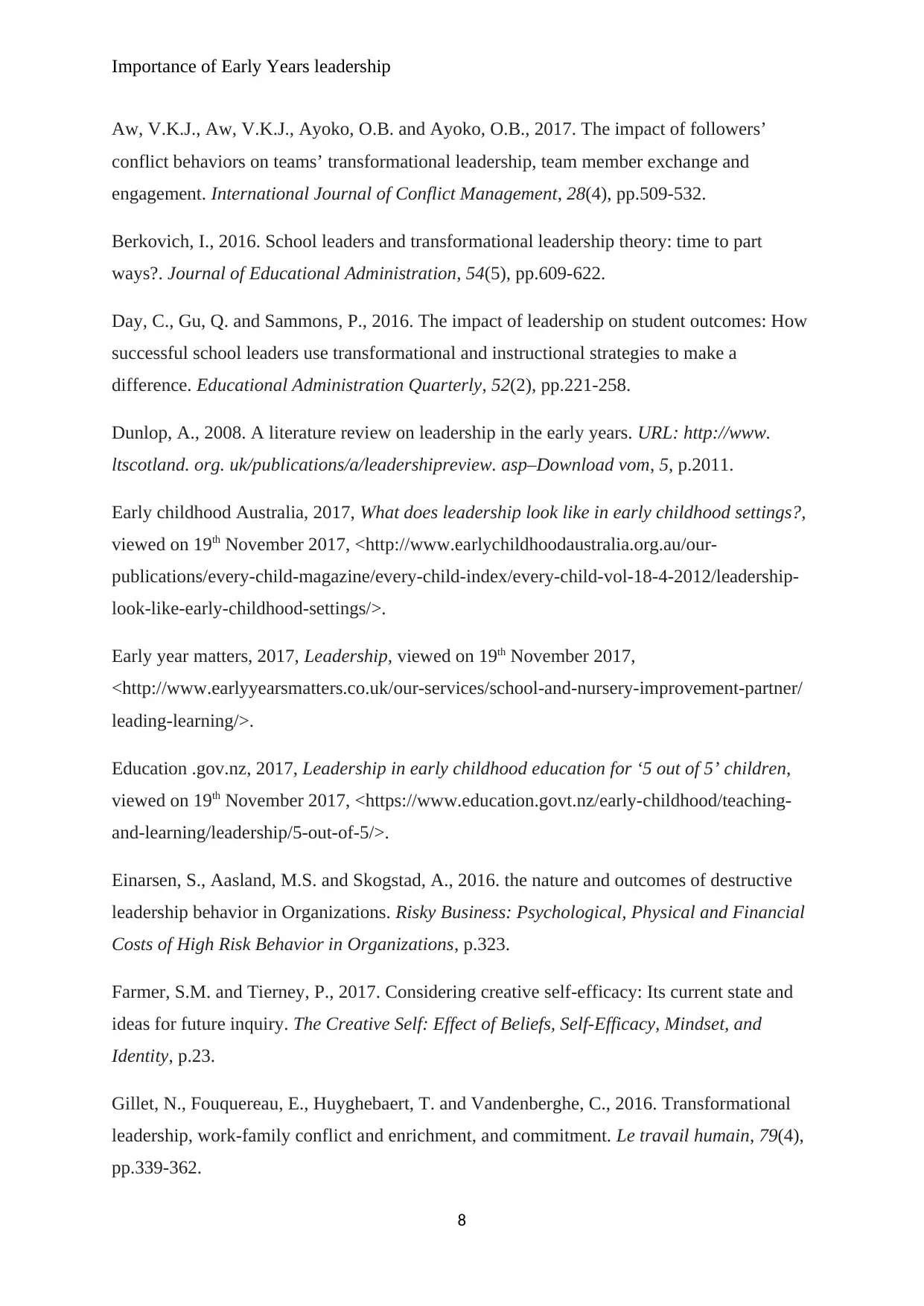
Importance of Early Years leadership
Aw, V.K.J., Aw, V.K.J., Ayoko, O.B. and Ayoko, O.B., 2017. The impact of followers’
conflict behaviors on teams’ transformational leadership, team member exchange and
engagement. International Journal of Conflict Management, 28(4), pp.509-532.
Berkovich, I., 2016. School leaders and transformational leadership theory: time to part
ways?. Journal of Educational Administration, 54(5), pp.609-622.
Day, C., Gu, Q. and Sammons, P., 2016. The impact of leadership on student outcomes: How
successful school leaders use transformational and instructional strategies to make a
difference. Educational Administration Quarterly, 52(2), pp.221-258.
Dunlop, A., 2008. A literature review on leadership in the early years. URL: http://www.
ltscotland. org. uk/publications/a/leadershipreview. asp–Download vom, 5, p.2011.
Early childhood Australia, 2017, What does leadership look like in early childhood settings?,
viewed on 19th November 2017, <http://www.earlychildhoodaustralia.org.au/our-
publications/every-child-magazine/every-child-index/every-child-vol-18-4-2012/leadership-
look-like-early-childhood-settings/>.
Early year matters, 2017, Leadership, viewed on 19th November 2017,
<http://www.earlyyearsmatters.co.uk/our-services/school-and-nursery-improvement-partner/
leading-learning/>.
Education .gov.nz, 2017, Leadership in early childhood education for ‘5 out of 5’ children,
viewed on 19th November 2017, <https://www.education.govt.nz/early-childhood/teaching-
and-learning/leadership/5-out-of-5/>.
Einarsen, S., Aasland, M.S. and Skogstad, A., 2016. the nature and outcomes of destructive
leadership behavior in Organizations. Risky Business: Psychological, Physical and Financial
Costs of High Risk Behavior in Organizations, p.323.
Farmer, S.M. and Tierney, P., 2017. Considering creative self-efficacy: Its current state and
ideas for future inquiry. The Creative Self: Effect of Beliefs, Self-Efficacy, Mindset, and
Identity, p.23.
Gillet, N., Fouquereau, E., Huyghebaert, T. and Vandenberghe, C., 2016. Transformational
leadership, work-family conflict and enrichment, and commitment. Le travail humain, 79(4),
pp.339-362.
8
Aw, V.K.J., Aw, V.K.J., Ayoko, O.B. and Ayoko, O.B., 2017. The impact of followers’
conflict behaviors on teams’ transformational leadership, team member exchange and
engagement. International Journal of Conflict Management, 28(4), pp.509-532.
Berkovich, I., 2016. School leaders and transformational leadership theory: time to part
ways?. Journal of Educational Administration, 54(5), pp.609-622.
Day, C., Gu, Q. and Sammons, P., 2016. The impact of leadership on student outcomes: How
successful school leaders use transformational and instructional strategies to make a
difference. Educational Administration Quarterly, 52(2), pp.221-258.
Dunlop, A., 2008. A literature review on leadership in the early years. URL: http://www.
ltscotland. org. uk/publications/a/leadershipreview. asp–Download vom, 5, p.2011.
Early childhood Australia, 2017, What does leadership look like in early childhood settings?,
viewed on 19th November 2017, <http://www.earlychildhoodaustralia.org.au/our-
publications/every-child-magazine/every-child-index/every-child-vol-18-4-2012/leadership-
look-like-early-childhood-settings/>.
Early year matters, 2017, Leadership, viewed on 19th November 2017,
<http://www.earlyyearsmatters.co.uk/our-services/school-and-nursery-improvement-partner/
leading-learning/>.
Education .gov.nz, 2017, Leadership in early childhood education for ‘5 out of 5’ children,
viewed on 19th November 2017, <https://www.education.govt.nz/early-childhood/teaching-
and-learning/leadership/5-out-of-5/>.
Einarsen, S., Aasland, M.S. and Skogstad, A., 2016. the nature and outcomes of destructive
leadership behavior in Organizations. Risky Business: Psychological, Physical and Financial
Costs of High Risk Behavior in Organizations, p.323.
Farmer, S.M. and Tierney, P., 2017. Considering creative self-efficacy: Its current state and
ideas for future inquiry. The Creative Self: Effect of Beliefs, Self-Efficacy, Mindset, and
Identity, p.23.
Gillet, N., Fouquereau, E., Huyghebaert, T. and Vandenberghe, C., 2016. Transformational
leadership, work-family conflict and enrichment, and commitment. Le travail humain, 79(4),
pp.339-362.
8
⊘ This is a preview!⊘
Do you want full access?
Subscribe today to unlock all pages.

Trusted by 1+ million students worldwide
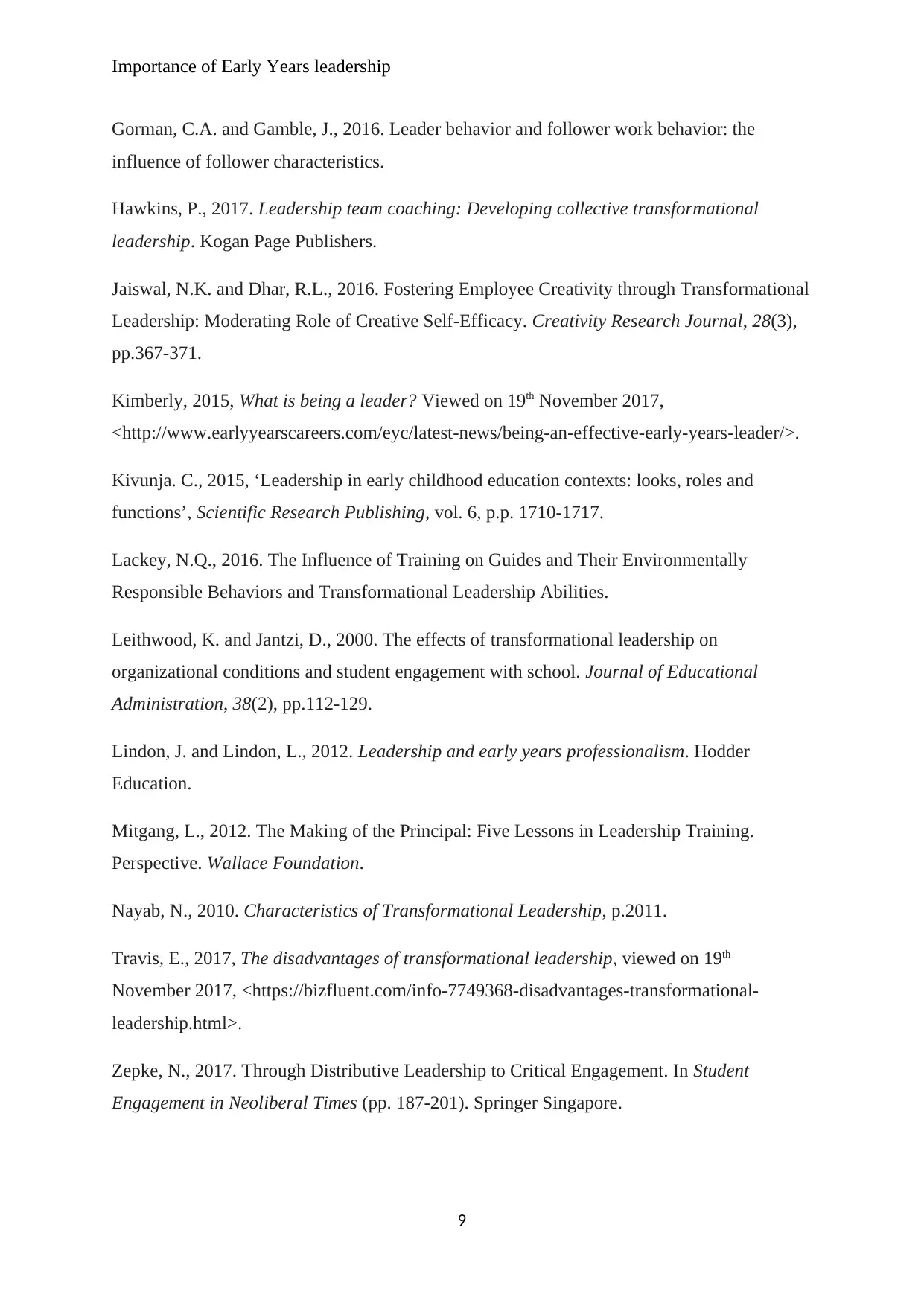
Importance of Early Years leadership
Gorman, C.A. and Gamble, J., 2016. Leader behavior and follower work behavior: the
influence of follower characteristics.
Hawkins, P., 2017. Leadership team coaching: Developing collective transformational
leadership. Kogan Page Publishers.
Jaiswal, N.K. and Dhar, R.L., 2016. Fostering Employee Creativity through Transformational
Leadership: Moderating Role of Creative Self-Efficacy. Creativity Research Journal, 28(3),
pp.367-371.
Kimberly, 2015, What is being a leader? Viewed on 19th November 2017,
<http://www.earlyyearscareers.com/eyc/latest-news/being-an-effective-early-years-leader/>.
Kivunja. C., 2015, ‘Leadership in early childhood education contexts: looks, roles and
functions’, Scientific Research Publishing, vol. 6, p.p. 1710-1717.
Lackey, N.Q., 2016. The Influence of Training on Guides and Their Environmentally
Responsible Behaviors and Transformational Leadership Abilities.
Leithwood, K. and Jantzi, D., 2000. The effects of transformational leadership on
organizational conditions and student engagement with school. Journal of Educational
Administration, 38(2), pp.112-129.
Lindon, J. and Lindon, L., 2012. Leadership and early years professionalism. Hodder
Education.
Mitgang, L., 2012. The Making of the Principal: Five Lessons in Leadership Training.
Perspective. Wallace Foundation.
Nayab, N., 2010. Characteristics of Transformational Leadership, p.2011.
Travis, E., 2017, The disadvantages of transformational leadership, viewed on 19th
November 2017, <https://bizfluent.com/info-7749368-disadvantages-transformational-
leadership.html>.
Zepke, N., 2017. Through Distributive Leadership to Critical Engagement. In Student
Engagement in Neoliberal Times (pp. 187-201). Springer Singapore.
9
Gorman, C.A. and Gamble, J., 2016. Leader behavior and follower work behavior: the
influence of follower characteristics.
Hawkins, P., 2017. Leadership team coaching: Developing collective transformational
leadership. Kogan Page Publishers.
Jaiswal, N.K. and Dhar, R.L., 2016. Fostering Employee Creativity through Transformational
Leadership: Moderating Role of Creative Self-Efficacy. Creativity Research Journal, 28(3),
pp.367-371.
Kimberly, 2015, What is being a leader? Viewed on 19th November 2017,
<http://www.earlyyearscareers.com/eyc/latest-news/being-an-effective-early-years-leader/>.
Kivunja. C., 2015, ‘Leadership in early childhood education contexts: looks, roles and
functions’, Scientific Research Publishing, vol. 6, p.p. 1710-1717.
Lackey, N.Q., 2016. The Influence of Training on Guides and Their Environmentally
Responsible Behaviors and Transformational Leadership Abilities.
Leithwood, K. and Jantzi, D., 2000. The effects of transformational leadership on
organizational conditions and student engagement with school. Journal of Educational
Administration, 38(2), pp.112-129.
Lindon, J. and Lindon, L., 2012. Leadership and early years professionalism. Hodder
Education.
Mitgang, L., 2012. The Making of the Principal: Five Lessons in Leadership Training.
Perspective. Wallace Foundation.
Nayab, N., 2010. Characteristics of Transformational Leadership, p.2011.
Travis, E., 2017, The disadvantages of transformational leadership, viewed on 19th
November 2017, <https://bizfluent.com/info-7749368-disadvantages-transformational-
leadership.html>.
Zepke, N., 2017. Through Distributive Leadership to Critical Engagement. In Student
Engagement in Neoliberal Times (pp. 187-201). Springer Singapore.
9
Paraphrase This Document
Need a fresh take? Get an instant paraphrase of this document with our AI Paraphraser

Importance of Early Years leadership
Zhao, H.H., Seibert, S.E., Taylor, M.S., Lee, C. and Lam, W., 2016. Not even the past: The
joint influence of former leader and new leader during leader succession in the midst of
organizational change. Journal of Applied Psychology, 101(12), p.1730.
Zhu, W., Avolio, B.J. and Walumbwa, F.O., 2009. Moderating role of follower
characteristics with transformational leadership and follower work engagement. Group &
Organization Management, 34(5), pp.590-619.
10
Zhao, H.H., Seibert, S.E., Taylor, M.S., Lee, C. and Lam, W., 2016. Not even the past: The
joint influence of former leader and new leader during leader succession in the midst of
organizational change. Journal of Applied Psychology, 101(12), p.1730.
Zhu, W., Avolio, B.J. and Walumbwa, F.O., 2009. Moderating role of follower
characteristics with transformational leadership and follower work engagement. Group &
Organization Management, 34(5), pp.590-619.
10
1 out of 11
Related Documents
Your All-in-One AI-Powered Toolkit for Academic Success.
+13062052269
info@desklib.com
Available 24*7 on WhatsApp / Email
![[object Object]](/_next/static/media/star-bottom.7253800d.svg)
Unlock your academic potential
Copyright © 2020–2025 A2Z Services. All Rights Reserved. Developed and managed by ZUCOL.





